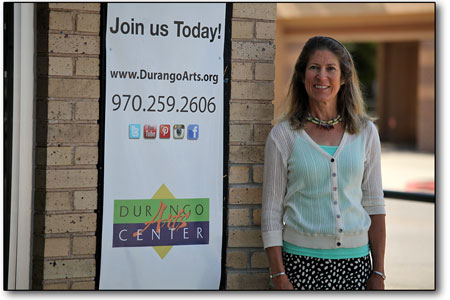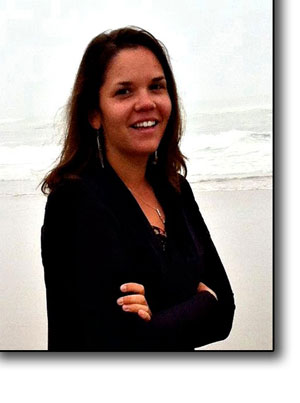|
|
Changing of the guard
Cristie Scott tapped to fill director vacancy left by Zemach
by Stew Mosberg
Peggy Zemach, the omnipresent executive director of the Durango Arts Center, had a tough act to follow when she took the reins from Sheri Rochford-Figgs in 2012. But now, nearly two years later, anyone familiar with the DAC knows she did it with outstanding results. According to Zemach, it’s not that she burned out or ran into problems; it was just time to move on.
When it became apparent last spring that Zemach was leaving, the DAC’s Board of Directors begun a national search in earnest with the goal of having a new director by July 8.
By early June, almost 40 candidates had submitted applications: 15 from Colorado, eight of who, were from Durango and Bayfield; and the remaining from a dozen other states, plus Toronto.
With such an array to choose from, narrowing the field was a tough job. Culling the candidates to a few finalists was initially accomplished through telephone interviews between the contenders and a search committee comprised of three board members: president Cristie Scott, Margie Dean Gray and Ginny Davis.
However, the perfect candidate was right under their noses all along.
|
Former DAC Board President Cristie Scott, who will succeed Peggy Zemach as executive director on Aug. 8./Courtesy photo |
Somewhere along the way, Scott realized that she herself would love to have the job. She summarily resigned from the board and the search committee and threw her hat into the ring.
Tim Kapustka, board V.P. at the time of Scott’s “soul-searching” decision, gave his assurance that “nepotism” never entered into the assessment. Scott underwent the same scrutiny and “grueling” interview process as all the other candidates. “She just kept coming up as the most appropriate choice,” Kapustka said.
So what does it take to be the executive director of the DAC? Not surprisingly, it requires multiple skills and expertise. The more apparent of these are administration, fundraising, and overall nonprofit acumen. An aspirant has to be willing to commit at least two years to the DAC, should have small-town fundraising experience and be comfortable managing a part-time staff. In compensation, the position comes with an annual salary of $50,000, health benefits and two weeks paid vacation, plus all federal holidays off.
Prior to being selected, Scott quipped, “The executive director of the Durango Arts Center has to be a Swiss army knife of administrators; able to manage on any given day staff reviews, complex building issues, interfacing with donors, writing grants and 4 attending community events on behalf of the organization.”
As if that weren’t enough, the director is expected to be a visionary leader, possess a passion for the arts and be able to cultivate relationships with the board, staff, donors, local artists, patrons and the general public.
Those who have worked with Scott say she fits the profile.
The DAC receives no public funding, so in addition to soliciting donors, the director must write grant proposals, plan special events and also execute capital campaigns when the need arises – a challenging role to say the least.
The DAC is currently generating a lot of momentum on the heels of both Zemach and Rochford-Figgs, who have done notable jobs of leading the organization and, as Scott previously remarked, promoting the DAC as “the true community asset it is; one that is fiscally sound and programmatically vibrant.”
Fundraising is a constant challenge that comes with the job, particularly in La Plata County where there are hundreds of causes vying for community support. As a result, Scott says, the DAC finds itself continually advocating for the importance of the arts alongside more basic needs like health and human services.
DAC taps useless knowledge to raise fundsTrivia buffs can vie for a wide range of prize, everything from spittoons to kegs, at Super Ted’s Super Trivia, a fundraising event for the Durango Arts Center, at 6:12 p.m. Wed., July 16, in the DAC Theatre.
Teams of up to five will compete in several rounds of general trivia (geography, history, sports, entertainment, etc.) There will be prizes for the overall winning team, the winners of each round as well as a slew of individual prizes.
Entry fee is $100/team and spectators can watch for just $5 (yes, there will be beer). Teams may register at the door beginning at 5 p.m. For more information, contact Ted Holteen at ted@DurangoArts.org or call 769-4174. |
When Zemach became director, she and the board worked together to set goals, the primary one being to develop a three-year strategic plan. One of the most significant outcomes of that plan was an increased earned revenue stream, in large part through theater rentals. In addition, Zemach declares one of her proudest achievements as working with the Southern Ute Museum and Cultural Center to host an exhibit showcasing the Ute culture. To help support that effort she acquired a $10,000 sponsorship from Conoco Phillips.
By her own admission, Zemach said her fundraising was a collaborative effort between her and the board. That effort has paid dividends during her tenure, with the DAC raising close to $1 million through events, sponsorships, memberships, donations, grants and earned income.
Combining resources with other organizations has been a major goal under Zemach’s directorship resulting in collaborations with not only the Southern Ute Tribe but the Center of SW Studies, Animas Museum, Durango High School, Mountain Middle School, Durango Cowboy Gathering and Studio &, to name a few. In addition to those groups the DAC also created sponsorships with over 30 businesses to support exhibits, theater and educational programs.
Going forward, Scott will have Rochford-Figgs and Zemach as role models along with the momentum they built. She will also have the full support of Kapustka, who stepped into her former role as board president. Nurturing partnerships with other organizations in the community is more important than ever as the DAC continues to outgrow its present facility. The torch officially passes into Scott’s hands on Aug. 8, at a crucial and exciting time for the DAC.
Juried Exhibit returns for 38th yearIn addition to debuting a new executive director, the Durango Arts Center will be opening two new exhibits this week, with receptions Friday from 5 - 7 p.m.
Downstairs, the DAC’s 38th annual Juried Exhibition will open in the Barbara Conrad Gallery, where it will remain on display through Aug. 9. The exhibit, which includes more than 100 works in a variety of mediums, was juried by Lisa Tamiris Becker, director of the University of New Mexico Art Museum. Across the street from the DAC, Steamworks Brewing will once again host the “Salon des Refuses,” featuring works not exhibited in the Juried Show. It will run concurrently with the DAC show. Also at the DAC, the upstairs Art Library will feature “Gathered Spaces” by Leslie Madigan (formerly Scheilberg). The exhibition explores Madigan’s relationship to the land with collages created from gathered materials. The work covers her travels to Ireland and throughout the United States, as well as time spent at her home in the Hudson River Valley, north of New York City. Madigan, who was one of the founding members of the DAC as well as its first director from 1981-88, will give a short talk at 7 p.m. |
In this week's issue...
- September 11, 2025
- Back on top
After harrowing flying accident, local highliner steps back out with renewed mission
- September 11, 2025
- New order
Rule change for Land and Water Conservation Fund raises alarms
- September 4, 2025
- Armed with knowledge
Local community organizers work to ensure immigrant neighbors know their rights


